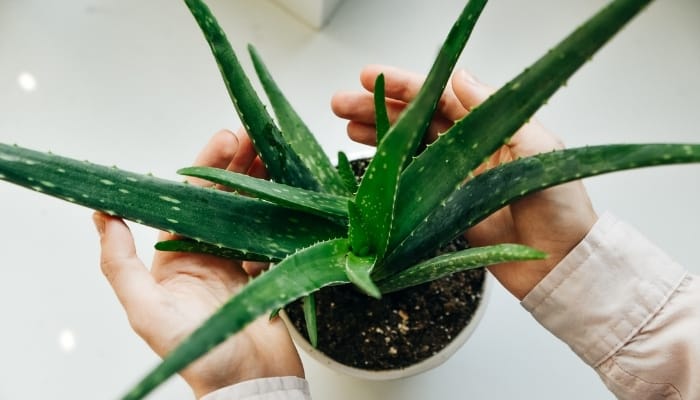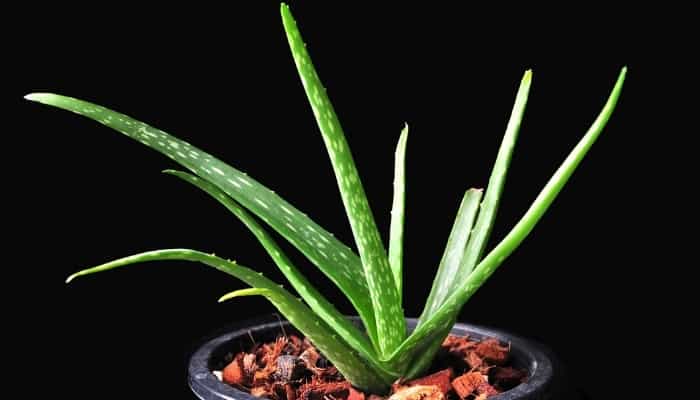Aloe vera is known for its resilience as a succulent, able to thrive in harsh growing conditions that would normally be fatal for other plants.
Propagating the plant is just as easy as caring for it. You can start a new aloe from just a leaf or a pup with no roots attached to it.
Supplies Needed
- Mature aloe vera plant
- Small pot
- Growing medium
- Stake for support
- Scissors
1. Look for Healthy Pups
Aloe pups come in two varieties. The first are pups that have roots that attach them to the mother plant. The other type is pups with no roots. They grow out of the side of the plant but are easy to lift.
Both types of pups are easy to propagate, even those without any roots at all. The difference is that pups with roots will grow faster.
A healthy pup will have a healthy green color, have some small shoots of its own, and average about 20 percent of the size of the mother plant.
2. Remove the Pups From the Plant
Rootless pups are easy to remove and pose no risk to the mother plant. The same cannot be said about pups with roots.
If you’re not careful when separating pups with roots, you could injure the stem of the aloe vera and cause an infection.
Look for a well-developed pup, and see if you can detach it from the mother aloe by just lifting it.
If it doesn’t come off, use sterilized scissors to separate the pup from the plant while paying attention to keeping the roots intact.
If there are no pups on the aloe plant, you can easily cut a leaf and plant it in the same way.
3. Set the Pups Aside To Callous
When you sever rootless pups, a liquid comes out of the cut, but if you leave it for a while, the liquid will gel, and the cut will callus over.
This is important for preventing the cut from rotting when you plant it in moist soil.
It will take the pup up to 2 days in a dry and cool place to heal the cut and develop a callus. It might take a little longer for the thick crust to develop over the cut depending on the humidity levels.
4. Prepare the Pot and Growing Medium
Since the pups have no roots, a large and deep pot is not necessary. In fact, it might harm the pups with the moisture buildup that could lead to fungal infections.
So, choose a small and shallow pot made of terracotta. Plastic pots tend to retain moisture and high temperature in the soil, which could damage the tender roots.
Fill the pot with a growing medium for succulents (this one is excellent).
Alternatively, you can mix your own medium using coarse sand and regular soil in equal portions with added gravel to create a loose textured mix.
5. Plant the Pup
When the cut on the pup or leaf is fully covered with a dry crust, you can plant the aloe. Dig a small hole about 1 inch deep, and place the callused cut in the soil.
Pack the soil around it to keep it standing upright. If the pup is too top-heavy and keels over, plant a stake next to it to give it support.
Water the pup immediately to get the soil moist but not wet.
6. Care for the Plant
Growing aloe without roots takes a lot of patience. These succulents don’t have a fast growth rate to start with, and without roots, the pup will focus first on developing roots before any new shoots emerge.
This can take up to a couple of months if not more.
During that time, make sure to water the soil regularly, but keep the watering light. When the pup develops roots, carefully transplant it to a larger and deeper pot filled with the same potting mix.

Aloe Vera Root Rot
Like many succulents, aloe vera doesn’t like to sit in waterlogged soil.
It can survive long periods of drought thanks to the stored moisture in its fleshy leaves, but it succumbs to root rot if the soil stays wet for a few days in a row.
You can tell that your aloe vera has root rot when you see discoloration in the leaves. The vibrant green leaves turn yellow and become mushy. In the advanced stages of root rot, the leaves will turn brown.
To fix root rot in aloe vera, pull out the plant by the roots, and examine its root ball. If more than half of the root system is rotten, dispose of the plant, and start a new one in fresh soil.
If only a part of the roots are damaged, trim off all rotten roots, and replant the aloe vera in a new pot with fresh soil.
Can You Grow Aloe Vera From a Cutting?
If the aloe vera plant you want to propagate from doesn’t have pups, you can easily cut a healthy leaf and plant it using the steps detailed above.
Don’t forget to let the cut leaf’s cut end callus over to prevent fungal and bacterial infections. The leaf will take a few months to develop roots, and then new leaves will emerge eventually.
Can an Aloe Plant Regrow Roots?
In general, if the aloe plant loses some of its roots as a result of mishandling or root rot, it will regrow new roots to replace them.
However, the amount of damage to the roots impacts the aloe plant’s ability to regrow roots.
If most of the roots are damaged, that will also affect the crown, and the whole plant will die. However, if you detect the problem in the early stages, the still-healthy plant can replace the lost roots.
Can You Root a Broken Piece of Aloe Plant?
A broken leaf of a healthy aloe vera plant is easy to root just like a pup. You’ll need to keep the broken leaf in a cool and dry place for a few days until the cut dries over and is covered with a thick crust.
This crust will protect the leaf against rot and bacterial infections when you plant it in the soil. Water the leaf sparingly until it develops roots a couple of months later.
How Long Does It Take for an Aloe To Root?
If you’re planting a pup with roots, it will develop a full root ball much faster than a rootless pup or a leaf. In general, a pup without roots will take between 2 and 3 months to develop roots.
Planting Aloe Pups Without Roots
Aloe pups without roots are easy to plant although they take longer to grow roots and leaves than starting the plant from pups with roots.
It’s crucial to let the cut at the bottom of the pup heal and callus over before planting the pup. The callus protects the pup against fungal spores and bacteria in the soil.
After planting the pup, water it lightly, and watch for signs of root development before transplanting it to a larger pot.
Conclusion
You can plant aloe pups without roots in a shallow pot filled with loose-textured growing medium.
Choose a healthy pup with shoots of its own, and let it callus over before planting it. When the pup develops roots of its own, transplant it to a deeper pot.

